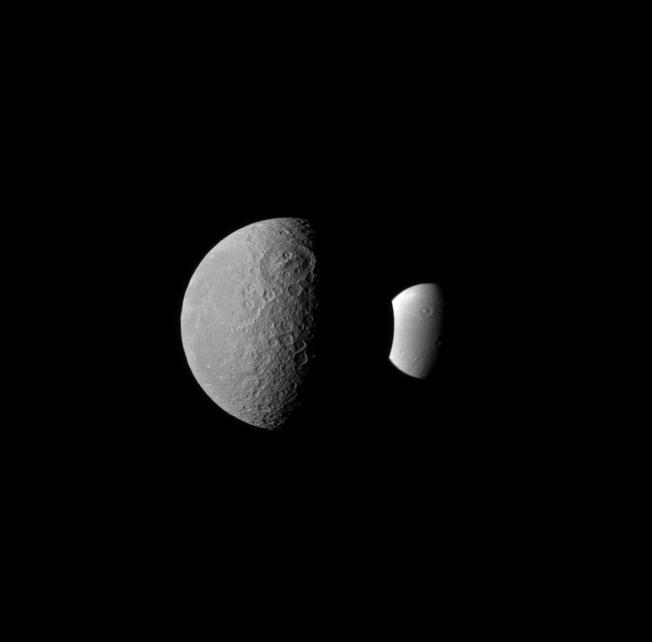Look-alike Moons

| PIA Number | PIA12760 |
|---|---|
| Language |
|
Rhea and Dione seem like dark and light fraternal twins in this Cassini spacecraft image, with each of these two Saturnian moons displaying a large crater oriented similarly in the northern hemisphere.
Rhea, on the left, is closer to the Cassini spacecraft than Dione in this view. Saturn is out-of-frame, far to the right of this view.
Lit terrain seen here is on the anti-Saturn side of Rhea (1,528 kilometers, or 949 miles across) and the leading hemisphere of Dione (1,123 kilometers, or 698 miles across). North on the moons is up.
The image was taken in visible blue light with the Cassini spacecraft narrow-angle camera on Feb. 3, 2011. The view was acquired at a distance of approximately 1.2 million kilometers (746,000 miles) from Rhea and at a Sun-Rhea-spacecraft, or phase, angle of 75 degrees. The view was acquired at a distance of approximately 1.9 million kilometers (1.2 million miles) from Dione and at a Sun-Dione-spacecraft, or phase, angle of 75 degrees. Image scale is 7 kilometers (4 miles) per pixel on Rhea and 11 kilometers (7 miles) per pixel on Dione.
The Cassini-Huygens mission is a cooperative project of NASA, the European Space Agency and the Italian Space Agency. The Jet Propulsion Laboratory, a division of the California Institute of Technology in Pasadena, manages the mission for NASA's Science Mission Directorate in Washington. The Cassini orbiter and its two onboard cameras were designed, developed and assembled at JPL. The imaging team is based at the Space Science Institute, Boulder, Colo.
For more information about the Cassini-Huygens mission visit http://saturn.jpl.nasa.gov or http://www.nasa.gov/cassini . The Cassini imaging team homepage is at http://ciclops.org .
Credit: NASA/JPL/Space Science Institute
